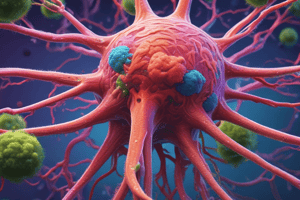Podcast
Questions and Answers
List and briefly describe the components of the lymphoid system.
List and briefly describe the components of the lymphoid system.
Lymphatic vessels, lymph, lymphocytes, lymphoid tissues, lymphoid organs.
Explain the flow of lymph through the lymphatic systems.
Explain the flow of lymph through the lymphatic systems.
Lymph flows through lymphatic capillaries, lymphatic vessels, lymph nodes, and eventually drains into the venous circulation.
Name the functions of the lymphatic system.
Name the functions of the lymphatic system.
Maintenance of fluid balance, fat absorption, and defense (immunity).
Explain the formation of lymph.
Explain the formation of lymph.
Describe the structure of lymphatic tissue.
Describe the structure of lymphatic tissue.
Lymph circulates through the lymph nodes, explain how and why this occurs.
Lymph circulates through the lymph nodes, explain how and why this occurs.
Describe the structure of the lymphatic vessels.
Describe the structure of the lymphatic vessels.
Describe the structure of the Thymus and Spleen.
Describe the structure of the Thymus and Spleen.
Explain the function of the thymus.
Explain the function of the thymus.
Explain the function of the spleen.
Explain the function of the spleen.
Flashcards are hidden until you start studying
Study Notes
Lymphatic System Overview
- Comprises tissues, cells, and organs defending against pathogens and internal threats like cancer.
- Pathogens include viruses, bacteria, fungi, and larger parasites, each attacking the body in unique ways.
Components of the Lymphatic System
- Lymphatic Vessels: Transport lymph from peripheral tissues to the venous system; comprised of lymphatic capillaries, trunks, and ducts (e.g., thoracic duct, right lymphatic duct).
- Lymph: Clear, yellowish fluid similar to plasma but with less protein; contains fats in the digestive tract, making it milky.
- Lymphocytes: Specialized cells including T-cells, B-cells, and natural killer (NK) cells, essential for immune responses.
- Lymphoid Tissues: Collections of lymphocytes in nodules; includes tonsils and MALT (in digestive, respiratory, urinary, and reproductive tracts).
- Lymphoid Organs: More complex structures like lymph nodes, spleen, and thymus, housing significant numbers of lymphocytes.
Functions of the Lymphatic System
- Fluid Balance: Maintains interstitial fluid levels; excess fluid enters lymphatic capillaries as lymph, preventing edema.
- Fat Absorption: Lymphatic vessels (lacteals) in the small intestine absorb triglycerides and transport them to the venous system.
- Defense/Immunity: Produces and distributes lymphocytes, vital for resisting infections.
Lymphatic Vessels
- Structure: Composed of blind-ending capillaries with overlapping endothelial cells, allowing one-way flow of lymph.
- Flow Direction: Lymph flows toward the heart through lymphatic capillaries, trunks, and ducts, eventually draining into subclavian veins.
Lymphoid Tissue
- Types:
- Nodules: Non-encapsulated, solid bodies, found in tonsils and Peyer’s patches.
- Diffuse Tissue: Scattered reticular cells and lymphocytes, with no clear boundaries; located in mucosal areas.
- MALT (Mucosa-associated lymphoid tissue): Specialized lymphoid tissue clusters in mucous membranes.
Tonsils
- Five main tonsils form a protective ring: paired palatine, single pharyngeal (adenoid), and paired lingual tonsils.
- Function: First line of defense against pathogens entering the pharynx.
Lymph Nodes
- Filter lymph to remove 99% of antigens; contain macrophages for pathogen destruction.
- Structure: Small, bean-shaped; composed of a dense connective tissue capsule with inner cortex and medulla.
- Lymphatic flow: Enters through afferent vessels, passes through sinuses for interaction with B and T lymphocytes, and exits via efferent vessels.
Thymus
- Located in the mediastinum, decreases in size after puberty.
- Role: Site for T cell maturation and differentiation; secretes thymic hormones (thymosins) crucial for T cell development.
Spleen
- Largest collection of lymphoid tissue, located in the upper abdomen, between the stomach and kidney.
- Functions: Filters blood, removes abnormal blood cells through phagocytosis, stores recycled iron, and initiates immune responses against antigens.
- Structure: Divided into white pulp (lymphoid nodules with lymphocytes) and red pulp (network of reticular fibers in blood).
Summary of Lymphatic Flow
- Lymph flows through a network of capillaries, trunks, and ducts and is directed by unidirectional valves to maintain movement against gravity.
Studying That Suits You
Use AI to generate personalized quizzes and flashcards to suit your learning preferences.




